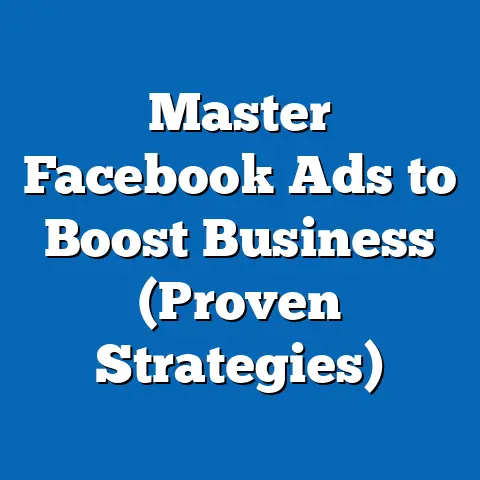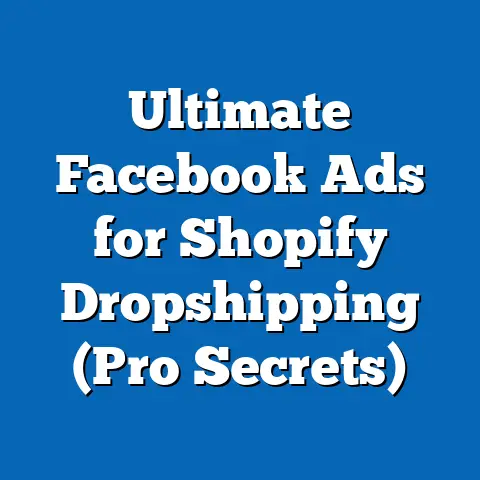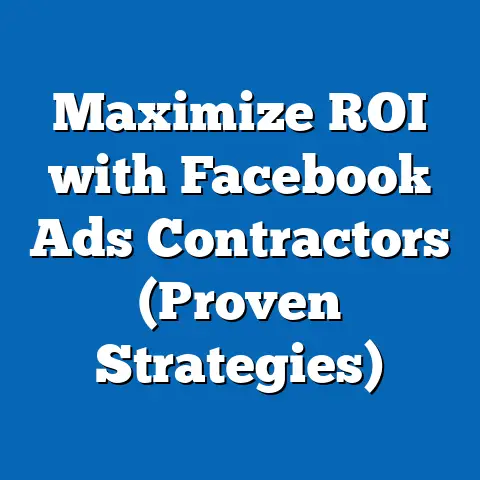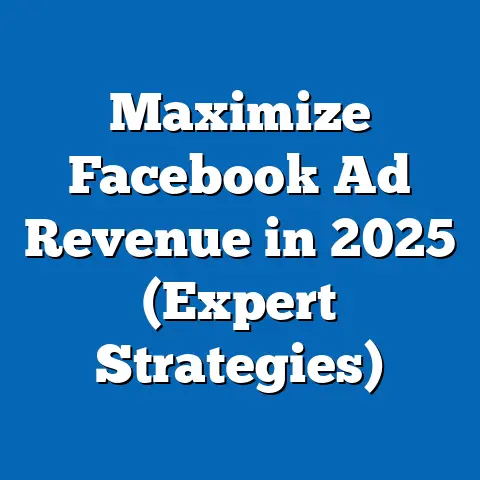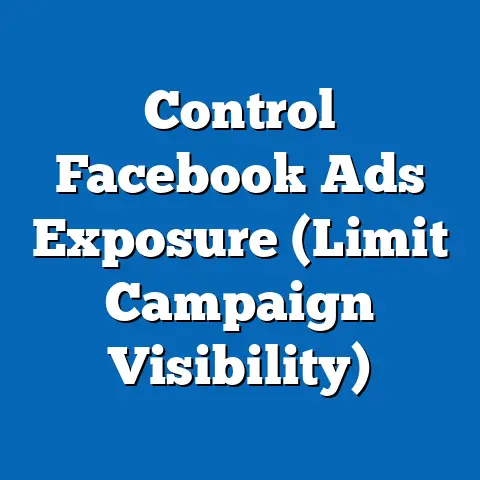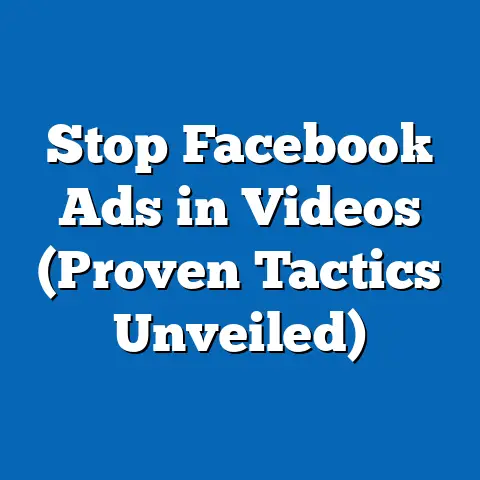Master fb ad Prep: Boost Performance (Actionable Insights)
Facebook advertising, as I’ve seen time and time again, isn’t just about throwing money at ads and hoping for the best. It’s a strategic game, and preparation is your most powerful weapon, especially when you’re targeting an audience that cares about the planet. In this guide, I’m going to walk you through everything you need to know to master Facebook ad preparation and boost your performance, with a special focus on reaching and resonating with eco-conscious consumers.
We’re living in a time where consumers are increasingly aware of their environmental impact. According to a recent study by Nielsen, 73% of global consumers say they would definitely or probably change their consumption habits to reduce their impact on the environment. This shift in consumer behavior is a goldmine for brands that are genuinely committed to sustainability. But simply claiming to be “green” isn’t enough. You need to communicate your values authentically and effectively, and that starts with meticulous ad preparation.
Understanding the Facebook Advertising Landscape
Facebook’s advertising ecosystem is vast and complex, but understanding its nuances is crucial for success. With over 2.9 billion monthly active users, Facebook offers unparalleled reach and targeting capabilities. However, this also means increased competition for ad space, making it essential to stand out from the crowd.
Demographics and Preferences:
Facebook’s user base is incredibly diverse, spanning all age groups, demographics, and interests. However, when targeting eco-conscious consumers, it’s important to note some key trends:
- Millennials and Gen Z: These generations are particularly passionate about sustainability and are more likely to support brands that align with their values.
- Affluent Consumers: Eco-friendly products often come with a premium price tag, so targeting higher-income households can be effective.
- Urban Dwellers: People living in cities are often more exposed to environmental issues and are more likely to seek out sustainable alternatives.
Aligning with Eco-Friendly Initiatives:
To effectively target eco-conscious consumers, your advertising campaigns need to be more than just visually appealing. They need to reflect a genuine commitment to sustainability. This means:
- Transparency: Be upfront about your company’s environmental practices and certifications.
- Authenticity: Avoid “greenwashing” – making misleading claims about your environmental efforts.
- Value-Driven Messaging: Focus on the positive impact your products or services have on the environment.
The Importance of Preparation in Facebook Ads
I’ve seen firsthand how proper preparation can make or break a Facebook ad campaign. It’s not enough to simply create an ad and hope it resonates with your target audience. You need to understand your market, segment your audience, and set clear goals.
Components of Ad Preparation:
- Market Research: Understand the needs and preferences of your target audience. What are their pain points? What motivates them?
- Audience Segmentation: Divide your audience into smaller groups based on demographics, interests, and behaviors. This allows you to tailor your messaging and ad creative for maximum impact.
- Goal-Setting: Define what you want to achieve with your ad campaign. Are you looking to increase brand awareness, generate leads, or drive sales?
Leveraging Unique Selling Propositions (USPs):
Eco-conscious brands often have unique selling propositions that can be leveraged in their ad preparations. These could include:
- Sustainable Materials: Highlight the use of recycled or renewable materials in your products.
- Ethical Manufacturing: Emphasize fair labor practices and responsible sourcing.
- Environmental Certifications: Display certifications like Fair Trade, USDA Organic, or B Corp.
Setting Up Your Facebook Ad Campaigns
Now, let’s dive into the nitty-gritty of setting up a Facebook ad campaign. I’ll walk you through the process step-by-step, with a focus on how to align your campaign objectives and ad formats with your eco-friendly goals.
Step-by-Step Process:
- Create a Facebook Business Account: If you don’t already have one, create a Facebook Business Account at business.facebook.com.
- Set Up Your Ad Account: Within your Business Account, create an ad account and link it to your Facebook Page.
- Define Your Campaign Objective: Choose an objective that aligns with your goals. For eco-conscious brands, consider objectives like:
- Brand Awareness: Increase awareness of your brand and its commitment to sustainability.
- Traffic: Drive traffic to your website to educate consumers about your eco-friendly products or services.
- Conversions: Generate leads or drive sales of your eco-friendly products.
- Define Your Target Audience: Use Facebook’s targeting options to reach your ideal customer. This includes demographics, interests, behaviors, and custom audiences.
- Set Your Budget and Schedule: Determine how much you’re willing to spend on your campaign and how long you want it to run.
- Create Your Ad Creative: Design visually appealing ads that resonate with your target audience.
- Track Your Results: Monitor your ad performance using Facebook Insights and make adjustments as needed.
- Brand Awareness: Increase awareness of your brand and its commitment to sustainability.
- Traffic: Drive traffic to your website to educate consumers about your eco-friendly products or services.
- Conversions: Generate leads or drive sales of your eco-friendly products.
Choosing the Right Campaign Objectives:
- Brand Awareness: Use this objective to reach a broad audience and increase awareness of your brand’s values and mission. For example, you could create an ad showcasing your company’s commitment to reducing carbon emissions.
- Traffic: Use this objective to drive traffic to your website where you can provide more detailed information about your eco-friendly products or services. For example, you could create an ad promoting a blog post about sustainable living tips.
- Conversions: Use this objective to generate leads or drive sales of your eco-friendly products. For example, you could create an ad offering a discount on your best-selling sustainable product.
Selecting Appropriate Ad Formats:
- Image Ads: Simple and effective for showcasing your products or services.
- Video Ads: Engaging and informative for telling your brand’s story and highlighting your commitment to sustainability.
- Carousel Ads: Allow you to showcase multiple products or features in a single ad.
- Collection Ads: Ideal for e-commerce businesses, allowing users to browse and purchase products directly from the ad.
Crafting Compelling Ad Content
The content of your ads is crucial for capturing the attention of your target audience and conveying your message effectively. Here are some actionable tips for creating engaging ad copy and visuals that resonate with eco-conscious consumers:
Engaging Ad Copy:
- Highlight the Benefits: Focus on the benefits of your eco-friendly products or services, such as reducing waste, conserving resources, or supporting ethical practices.
- Use Strong Verbs: Use verbs that evoke emotion and inspire action, such as “protect,” “preserve,” or “restore.”
- Tell a Story: Share stories about your company’s commitment to sustainability or the positive impact your products have on the environment.
- Use Social Proof: Include testimonials or reviews from satisfied customers who appreciate your eco-friendly practices.
- Include a Clear Call to Action: Tell users what you want them to do, such as “Learn More,” “Shop Now,” or “Join Our Movement.”
Visuals That Highlight Sustainability:
- Use Natural Imagery: Incorporate images of nature, such as forests, oceans, or wildlife, to evoke a sense of environmental responsibility.
- Showcase Sustainable Materials: Highlight the use of recycled or renewable materials in your products.
- Emphasize Ethical Manufacturing: Show images of fair labor practices and responsible sourcing.
- Use Authentic Photography: Avoid using stock photos that look generic or staged.
- Create Visually Appealing Graphics: Use graphics to illustrate the environmental benefits of your products or services.
Examples of Successful Ad Campaigns:
- Patagonia: Known for its commitment to environmental activism, Patagonia often uses its ads to raise awareness about environmental issues and promote sustainable practices.
- Allbirds: This sustainable shoe brand uses its ads to highlight the use of natural materials and its commitment to reducing carbon emissions.
- Seventh Generation: This eco-friendly cleaning products company uses its ads to promote its commitment to sustainability and its efforts to reduce waste.
Targeting and Retargeting Strategies
Targeting the right audience is essential for maximizing the effectiveness of your Facebook ad campaigns. Here’s a breakdown of the various targeting options available on Facebook and how you can use them to reach eco-conscious consumers:
Targeting Options:
- Demographics: Target users based on age, gender, location, education, and other demographic factors.
- Interests: Target users based on their interests, such as “sustainability,” “environmentalism,” “eco-friendly living,” or “organic food.”
- Behaviors: Target users based on their online behavior, such as their purchase history, the websites they visit, or the apps they use.
- Custom Audiences: Create custom audiences based on your existing customer data, such as email lists or website visitors.
- Lookalike Audiences: Create lookalike audiences based on your custom audiences. Facebook will identify users who share similar characteristics with your existing customers.
Creating Custom and Lookalike Audiences:
- Custom Audiences: Upload your email list to Facebook to create a custom audience of your existing customers. You can then target these customers with ads promoting new products or services.
- Lookalike Audiences: Create a lookalike audience based on your custom audience of existing customers. This allows you to reach new customers who are likely to be interested in your eco-friendly products or services.
Retargeting Strategies:
Retargeting is a powerful strategy for reminding users of eco-friendly products they’ve shown interest in. Here are some retargeting tactics you can use:
- Website Visitors: Retarget users who have visited your website but haven’t made a purchase.
- Product Page Visitors: Retarget users who have viewed specific product pages but haven’t added the products to their cart.
- Abandoned Cart Users: Retarget users who have added products to their cart but haven’t completed the checkout process.
Utilizing Facebook Insights for Optimization
Facebook Insights is a powerful tool for monitoring your ad performance and identifying areas for improvement. Here’s how you can use Facebook Insights to optimize your ad campaigns for eco-conscious brands:
Monitoring Ad Performance:
- Reach: Track the number of people who have seen your ads.
- Engagement: Track the number of likes, comments, shares, and clicks your ads have received.
- Conversions: Track the number of leads or sales your ads have generated.
- Cost Per Result: Track the cost per lead, cost per sale, or cost per other desired outcome.
Interpreting Data:
- Identify High-Performing Ads: Analyze which ads are generating the most engagement and conversions.
- Identify Low-Performing Ads: Analyze which ads are not performing well and identify areas for improvement.
- Understand Your Audience: Analyze the demographics, interests, and behaviors of the users who are engaging with your ads.
Actionable Tips for Optimization:
- Refine Your Targeting: Adjust your targeting options to reach a more relevant audience.
- Improve Your Ad Creative: Experiment with different ad copy, visuals, and calls to action to see what resonates best with your audience.
- Optimize Your Bidding Strategy: Adjust your bidding strategy to maximize your ad visibility and minimize your cost per result.
- Test Different Ad Formats: Experiment with different ad formats to see which ones generate the most engagement and conversions.
Budgeting and Bidding Strategies
Setting a budget that aligns with both your performance goals and your eco-friendly initiatives is crucial for maximizing your ROI. Here’s a guide to budgeting and bidding strategies for Facebook ad campaigns:
Setting a Budget:
- Determine Your Goals: What do you want to achieve with your ad campaign? Are you looking to increase brand awareness, generate leads, or drive sales?
- Estimate Your Potential ROI: How much revenue do you expect to generate from your ad campaign?
- Allocate Your Budget: Allocate your budget based on your goals and your potential ROI.
Exploring Bidding Strategies:
- Lowest Cost Bidding: Facebook will automatically bid for you to get the lowest possible cost per result.
- Cost Cap Bidding: You set a target cost per result, and Facebook will try to achieve that cost while maximizing your results.
- Bid Cap Bidding: You set a maximum bid for each auction, giving you more control over your ad spend.
- Target Cost Bidding: Facebook will try to get you the most results while staying within your target cost per result.
Allocating Budget Effectively:
- Prioritize High-Performing Ad Sets: Allocate more budget to ad sets that are generating the most engagement and conversions.
- Test Different Ad Sets: Experiment with different ad sets to see which ones perform best.
- Monitor Your Results: Monitor your ad performance and make adjustments to your budget allocation as needed.
A/B Testing for Continuous Improvement
A/B testing is a powerful tool for refining your ad strategies and improving your results. Here’s a guide to A/B testing for Facebook ad campaigns:
Concept of A/B Testing:
A/B testing involves creating two versions of an ad (A and B) and testing them against each other to see which one performs better. You can test different elements of your ads, such as:
- Headlines: Test different headlines to see which ones capture the most attention.
- Images: Test different images to see which ones resonate best with your audience.
- Call-to-Action Buttons: Test different call-to-action buttons to see which ones generate the most clicks.
- Ad Copy: Test different ad copy to see which one conveys your message most effectively.
Examples of Elements to Test:
- Identify the Winning Ad: Determine which ad performed better based on your key metrics, such as engagement, conversions, or cost per result.
- Analyze the Results: Understand why the winning ad performed better. What elements made it more effective?
- Implement the Findings: Apply the findings from your A/B test to future ad campaigns.
Case Studies from Successful Eco-Conscious Brands
Let’s take a look at some case studies from brands that have successfully implemented Facebook ads focused on eco-conscious messaging:
Patagonia:
- Campaign: Patagonia’s “Worn Wear” campaign encouraged consumers to repair and reuse their clothing instead of buying new items.
- What Worked: The campaign resonated with consumers who were looking for ways to reduce their environmental impact.
- Impact: The campaign increased brand awareness and drove traffic to Patagonia’s website.
Allbirds:
- Campaign: Allbirds used Facebook ads to highlight the use of natural materials in its shoes and its commitment to reducing carbon emissions.
- What Worked: The ads appealed to consumers who were looking for sustainable and comfortable footwear.
- Impact: The campaign increased sales and established Allbirds as a leader in the sustainable footwear industry.
Seventh Generation:
- Campaign: Seventh Generation used Facebook ads to promote its commitment to sustainability and its efforts to reduce waste.
- What Worked: The ads resonated with consumers who were looking for eco-friendly cleaning products.
- Impact: The campaign increased sales and strengthened Seventh Generation’s brand image.
Conclusion
Mastering Facebook ad preparation is a critical step in boosting performance, especially for eco-conscious brands aiming to connect with a growing audience of environmentally aware consumers. By understanding the Facebook advertising landscape, setting clear goals, crafting compelling ad content, targeting the right audience, and continuously optimizing your campaigns, you can achieve significant results while contributing positively to the planet.
Key Actionable Insights:
- Prioritize authenticity and transparency in your messaging.
- Target eco-conscious consumers based on their demographics, interests, and behaviors.
- Use visuals that highlight sustainability and ethical practices.
- Continuously monitor your ad performance and make adjustments as needed.
- A/B test different elements of your ads to see what resonates best with your audience.
Call to Action:
Start implementing these actionable insights in your Facebook ad campaigns today to not only enhance performance but also contribute positively to the planet. The future of advertising is sustainable, and by mastering Facebook ad preparation, you can position your brand for long-term success in a world that increasingly values environmental responsibility.

